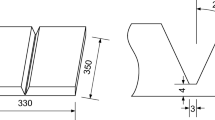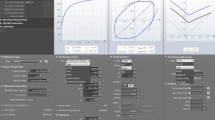Abstract
In automotive industry, parts made of aluminum alloys are used with increasing frequency. During forging operations for the production of aluminum long flat pieces, defects like folds can appear. Especially internal folds are of interest, which are only evident in the fiber orientation and have a negative effect on the dynamic mechanical properties of the forged part. In forging, the forming operation can be realized either from one direction (uni-directional) or from several directions (multi-directional). The boundary conditions for multi-directional forging are described in this article. For a given tool geometry, multi-directional forging permits the realization of fold-free forgings, which has been shown to be not possible with uni-directional operations. A newly developed method based on finite-elements-analysis simulation helps with the design of the forming process and the determination of the appropriate tool geometry. A new algorithm integrates the computer-aided identification of internal folds. For a given process and tool geometry, the area with internal folds is adjusted, until the simulation shows no fold formation. It is shown, that by using this model, a dependable assessment and correction of forging tools and forming process and thus the realization of a fold-free forming are possible.












Similar content being viewed by others
Abbreviations
- FEA:
-
Finite-elements-analysis
- IPH:
-
Institut für Integrierte Produktion Hannover gemeinnützige GmbH
References
N N (2009) Verband der Automobilindustrie e. V. Jahresbericht, Frankfurt am Main
Hirsch J (2009) Aluminium in innovative light-weight car design. In: European aluminium congress, pp 101–114
Becker J, Hilpert M, Terlinde G (2009) Aluminiumstrangpressprofile für den Automobilbau—neue Lösungen zum verbesserten Leichtbau. Aluminium 5:34–43
Bittrich A (2003) Wirtschaftlicher Leichtbau mit Aluminium-Schmiedestücken. Konferenz-Einzelbericht: 1. Landshuter Leichtbaukolloquium, Innovation und Erfahrungen im Leichtbau-Kompetenznetzwerk, Landshut, pp 227–234
Doege E, Behrens B-A (2007) Handbuch Umformtechnik—Grundlagen, Technologien, Maschinen. Springer, Berlin
Spieß K (1957) Eine Formenordnung für Gesenkschmiedestücke. Werkstatttechnik und Maschinenbau 47:201–205
Awiszus B, Bast J, Dürr H, Matthes K-J (2009) Grundlagen der Fertigungstechnik. Carl Hanser, München
Westhof J (1990) Einfluß hoher Werkstücktemperaturen auf die Bauteilfestigkeit von Aluminiumknetlegierungen. VDI, Düsseldorf
Li F, Lin JF, Chu GN (2009) Metal flow in the precision forging of aluminum alloys. JOM 61:57–60
Stonis M, Lücke M, Nickel R (2008) Forging of long flat pieces of aluminium with a precise mass distribution operation. In: TMS annual meeting and exhibition: aluminum alloys: fabrication, characterization and applications, 9th–13th March 2008, New Orleans, USA, pp 61–66
Stonis M (2011) Mehrdirektionales Schmieden von flachen Aluminiumlangteilen. Berichte aus dem IPH. PZH Verlag, Garbsen
Behrens B-A, Nickel R, Müller S (2009) Flashless precision forging of a two-cylinder crankshaft. Prod Eng 3:381–389
Czechowski D, Schott A, Telkamp K (2004) Gefügeuntersuchungen beim Aluminiumschmieden. Schmiede J 2:26–27
Ostermann F (1998) Anwendungstechnologie aluminum. Springer, Heidelberg
Müller S (2009) Methode zur Schrumpfungskorrektur beim gratlosen Präzisionsschmieden. Schmiede J 3:26–29
Merziger G, Mühlbach G, Wille D, Wirth T (1996) Formeln + Hilfen zur Höheren Mathematik. Binomi, Springe
Acknowledgments
The authors thank the German Research Foundation (Deutsche Forschungsgemeinschaft) for the funding of the research project “Aluminiumschmieden von Langteilen mit genauer Massevorverteilung” (DFG Do 190/167-1 and DFG Be 1691/19-2).
Conflict of interest
The authors declare that they have no conflict of interest.
Author information
Authors and Affiliations
Corresponding author
Rights and permissions
About this article
Cite this article
Behrens, BA., Nickel, R. & Stonis, M. Simulation algorithm for the assessment and modification of multi-directional forging processes and tool geometries. Prod. Eng. Res. Devel. 6, 187–198 (2012). https://doi.org/10.1007/s11740-012-0364-z
Received:
Accepted:
Published:
Issue Date:
DOI: https://doi.org/10.1007/s11740-012-0364-z




